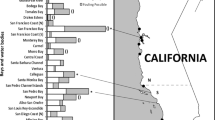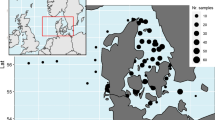Abstract
Secondary transport of introduced species can be important in dispersing potentially invasive species, and vectors of transport are often the fouled hulls of small fishing and recreational boats. Likelihood of transport depends on many factors, including resistance of the species to drag forces due to boat velocity and resistance to desiccation. To experimentally test the importance of drag on transport, we attached plates with a preexisting, 4 months old, assemblage of species, on a boat hull that was then subjected to one of three speeds (5, 15 and 20 knots) for 20 min. We experimentally tested desiccation tolerance with colonized plates that were exposed to the air for 3–132 h, after which they were examined for living organisms. A total of 35 taxa were identified, including introduced species, in southern Brazil: the barnacles Amphibalanus amphitrite, A. reticulatus and the octocoral Stragulum bicolor. In the drag experiment, all species survived transport. In the desiccation experiment, most species survived more than 6 h (fewer species much longer) of exposure to the air. Our results illustrate that a variety of taxa and growth forms can be transported over regional scales at speeds and travel conditions typical of small boats. They can also survive desiccation conditions typical of overland transportation of small boats. Thus, we recommend that additional management mechanisms must be put in place to reduce the probability of invasion due to secondary transport.




Similar content being viewed by others
References
Andriguetto-Filho JM, Krul R, Feitosa S (2009) Analysis of natural and social dynamics of fishery production systems in Paraná, Brazil: implications for management and sustainability. J Appl Ichthyol 25:277–286
Ashton G, Boos K, Shucksmith R, Cook E (2006) Risk assessment of hull fouling as a vector for marine non-natives in Scotland. Aquat Invasions 1:214–218
Ashton G, Davidson I, Ruiz G (2014) Transient small boats as a long-distance coastal vector for dispersal of biofouling organisms. Estuar Coasts 37:1572–1581. doi:10.1007/s12237-014-9782-9
Bell J (2002) Regeneration rates of a sublittoral demosponge. J Mar Biol Assoc UK 82:169–170
Brandini FP, Silva AA (2011) Epilithic community development on artificial reefs deployed along a cross-shelf environmental gradient off Parana State, Southern Brazil. Braz J Oceanogr 59:43–53
Brasil (2013) Lei nº 12.829, de 20 de junho de 2013. http://www.icmbio.gov.br/cepsul/images/stories/legislacao/Lei/2013/lei_12829_uc_cria_parna_marinho_ilhasdoscurrais_pr.pdf
Brown FD, Keeling EL, Le AD, Swalla BJ (2009) Whole body regeneration in a colonial ascidian, Botrylloides violaceus. Mol Dev Evol 312B:885–900
Bulleri F, Airoldi (2005) Artificial marine structures facilitate the spread of a nonindigenous green alga, Codium fragile ssp. tomentosoides, in the north Adriatic Sea. J Appl Ecol 42:1063–1072
Bumbeer J, Rocha RM (2016) Invading the natural marine substrates: a case study with invertebrates in South Brazil. Zoologia 33:e20150211
Calder D, Mayal E (1998) Dry season distribution of hydroids in a small tropical estuary, Pernambuco, Brazil. Zool Verh 323:69–78
Carlton JT, Newman WA, Pitombo FB (2011) Barnacle invasions: introduced, cryptogenic, and range expanding Cirripedia of North and South America. In: Galil BS, Clark PF, Carlton JT (eds) In the wrong place—alien marine crustaceans: distribution, biology and impacts invading nature, vol 6., Springer Series in Invasion EcologySpringer, Dordrecht, pp 159–213. doi:10.1007/978-94-007-0591-3_1
Clarke Murray C, Pakhomov EA, Therriault TW (2011) Recreational boating: a large unregulated vector transporting marine invasive species. Divers Distrib 17:1161–1172
Clarke Murray C, Therriault TW, Martone PT (2012) Adapted for invasion? Comparing attachment, drag and dislodgement of native and nonindigenous hull fouling species. Biol Invasions 14:1651–1663
Coutts ADM, Taylor MD (2004) A preliminary investigation of biosecurity risks associated with biofouling on merchant vessels in New Zealand. N Z J Mar Freshw Res 38:215–229
Coutts ADM, Piola RF, Hewitt CL, Connell SD, Gardner JPA (2010a) Effect of vessel voyage speed on survival of biofouling organisms: implications for translocation of non-indigenous marine species. Biofouling 26:1–13. doi:10.1080/08927010903174599
Coutts ADM, Piola RF, Taylor MD, Hewitt CL, Gardner JP (2010b) The effect of vessel speed on the survivorship of biofouling organisms at different hull locations. Biofoul 26:539–553
Dafforn KA, Lewis JA, Johnston EL (2011) Antifouling strategies: History and regulation, ecological impacts and mitigation. Mar Pollut Bull 62:453–465
Darbyson E, Locke A (2009) Marine boating habits and the potential for spread of invasive species in the Gulf of St. Lawrence. Aquat Invasions 4:87–94
Davidson IC, McCann LD, Fofonoff PW, Sytsma MD, Ruiz GM (2008) The potential for hull-mediated species transfers by obsolete ships on their final voyages. Divers Distrib 14:518–529
Davidson IC, Zabin C, Chang A, Brown C, Sytsma M, Ruiz G (2010) Recreational boats as potential vectors of marine organisms at an invasion hotspot. Aquat Biol 11:179–191
Drake JM, Lodge DM (2007) Hull fouling is a risk factor for intercontinental species exchange in aquatic ecosystems. Aquat Invasions 2:121–131
Floerl O, Inglis GJ (2003) Boat harbour design can exacerbate hull fouling. Austral Ecol 28:116–127
Foster V, Giesler RJ, Wilson AMW, Nall CR, Cook EJ (2016) Identifying the physical features of marina infrastructure associated with the presence of non-native species in the UK. Mar Biol 163:173
Gillis NK, Walters LJ, Fernandes FC, Hoffman EA (2009) Higher genetic diversity in introduced than in native populations of the mussel Mytella charruana: evidence of population admixture at introduction sites. Divers Distrib 15:784–795. doi:10.1111/j.1472-4642.2009.00591.x
Godwin LS (2003) Hull fouling of maritime vessels as a pathway for marine species invasions to the Hawaiian Islands. Biofoul 19(suppl):123–131
Gollasch S (2002) The importance of hull fouling as a vector of species introduction in the North Sea. Biofouling 18:105–121
Gosselin LA, Pei-Yuan Q (1997) Juvenile mortality in benthic marine invertebrates. Mar Ecol Prog Ser 146:265–282. doi:10.3354/meps146265
Hedge LH, Johnston EL (2012) Propagule pressure determines recruitment from a commercial shipping pier. Biofouling 28:73–85. doi:10.1080/08927014.2011.652622
Hillock KA, Costello MJ (2013) Tolerance of the invasive tunicate Styela clava to air exposure. Biofouling 29:1–7. doi:10.1080/08927014.2013.832221
Johannesson K (1988) The paradox of Rockall—why is a brooding gastropod (Littorina saxatilis) more widespread than one having a planktonic larval dispersal stage (L. littorea)? Mar Biol 99:507–513. doi:10.1007/BF00392558
Johnson L, Ricciardi A, Carlton JT (2001) Overland dispersal of aquatic invasive species: a risk assessment of transient recreational boating. Ecol Appl 11:1789–1799
Jute AHC, Gobin JF, Rocha RM (2013) A preliminary list of ascidians for the island of Trinidad, West Indies. Mar Biodivers Rec 6:e62. doi:10.1017/S1755267213000390
Lacoursière-Roussel A, Forrest BM, Guichard F, Piola RF, McKindsey CW (2012) Modeling biofouling from boat and source characteristics: a comparative study between Canada and New Zealand. Biol Invasions 14:2301–2314
Leonard J (2009) Hull fouling surveys of recreational boats in Hawaii. Hawaii Department of Land and Natural Resources, Department of Aquatic Resources Report
Lord JP, Calini JM, Whitlatch RB (2015) Influence of seawater temperature and shipping on the spread and establishment of marine fouling species. Mar Biol 162:2481–2492. doi:10.1007/s00227-015-2737-2
Marshall DJ, Keough MJ (2003) Variation in the dispersal potential of non-feeding invertebrate larvae: the desperate larva hypothesis and larval size. Mar Ecol Prog Ser 255:145–153
Minchin D, Floerl O, Savini D, Occhipinti-Ambrogi A (2006) Small craft and the spread of exotic species. In: Davenport J, Davenport JL (eds) The ecology of transportation: managing mobility for the environment. Springer, Dordtrecht, pp 99–118
Mineur F, Johnson MP, Maggs CA (2008) Macroalgal introductions by hull fouling on recreational vessels: Seaweeds and sailors. Environ Manag 42:667–676. doi:10.1007/s00267-008-9185-4
Morris JA, Carman MR (2012) Fragment reattachment, reproductive status, and health indicators of the invasive colonial tunicate Didemnum vexillum with implications for dispersal. Biol Invasions 14:2133–2140
Neves CS, Rocha RM, Bettini-Pitombo F, Roper JJ (2007) Use of artificial substrata by introduced and cryptogenic marine species in Paranagua Bay, southern Brazil. Biofouling 23:319–330. doi:10.1080/08927010701399174
Palumbi SR, Jackson JBC (1982) Ecology of cryptic coral reef communities. II. Recovery from small disturbance events by encrusting bryozoa: the influence of “host” species and lesion size. J Exp Mar Biol Ecol 64:103–115. doi:10.1016/0022-0981(82)90147-2
Pineda MC, McQuaid CD, Turon X, Lopez-Legentil S, Ordoñez V (2012) Tough adults, frail babies: an analysis of stress sensitivity across early life-history stages of widely introduced marine invertebrates. PLoS ONE 7(10):e46672. doi:10.1371/journal.pone.0046672
PROZEE (2005) Fundação de Amparo à Pesquisa de Recursos Vivos na Zona Econômica Exclusiva. Relatório técnico sobre o censo estrutural da pesca artesanal marítima e estuarina nos estados do Espírito Santo, Rio de Janeiro, Paraná, Santa Catarina e Rio Grande do Sul. Convênio SEAP/IBAMA/PROZEE Nº 110/2004
R Development Core Team (2016) R: a language and environment for statistical computing. R Foundation for Statistical Computing, Vienna, Austria. http://www.R-project.org/
Van Ofwegen L, Haddad MA (2011) A probably invasive new genus and new species of soft coral (Octocorallia: Alcyonacea: Clavulariidae) from Brazil. Zootaxa 46:38–46
Wasson K, Zabin CJ, Bedinger L, Cristina Diaz M, Pearse JS (2001) Biological invasions of estuaries without international shipping: the importance of intraregional transport. Biol Conserv 102:143–153
WHOI (Woods Hole Oceanographic Institute) (1952) Marine fouling and its prevention. US Naval Institute, Annapolis
Winston J (1995) Ectoproct diversity of the Indian River coastal lagoon. Bull Mar Sci 57:84–93
Wulff J (2006) Resistance vs recovery: morphological strategies of coral reef sponges. Funct Ecol 20:699–708. doi:10.1111/j.1365-2435.2006.01143.x
Zabin CJ, Ashton GV, Brown CW, Davidson IC, Sytsma MD, Ruiz GM (2014) Small boats provide connectivity for nonindigenous marine species between a highly invaded international port and nearby coastal harbors. Manag Biol Invasions 5:97–112
Acknowledgements
We thank the Caiobá Yatch Club for their many forms of support and allowing us the use of their space. We also thank the specialists that contributed with species identifications (Helena Matthews-Cascon—Mollusca, Leandro Manzoni Vieira—Bryozoa, Ana Caroline Cabral—Hydrozoa, Sula Salani—Porifera), and CAPES foundation for the scholarship to RVK and the National Counsel of Technological and Scientific Development—CNPq for their research support Grants for RMR (305201/2014-0) and JJR (306963/2012-4).
Author information
Authors and Affiliations
Corresponding author
Ethics declarations
Conflict of interest
The three authors declare no conflict of interest.
Ethical approval
All applicable international, national and/or institutional guidelines for the care and use of animals were followed. Samples were collected under the license SISBIO 10011-1.
Human rights statement
This article does not contain any studies with human participants performed by any of the authors.
Additional information
Responsible Editor: E. Briski.
Reviewed by undisclosed experts.
This article is part of the Topical Collection on Invasive Species.
Electronic supplementary material
Below is the link to the electronic supplementary material.
Rights and permissions
About this article
Cite this article
Kauano, R.V., Roper, J.J. & Rocha, R.M. Small boats as vectors of marine invasion: experimental test of velocity and desiccation as limits. Mar Biol 164, 27 (2017). https://doi.org/10.1007/s00227-016-3057-x
Received:
Accepted:
Published:
DOI: https://doi.org/10.1007/s00227-016-3057-x




